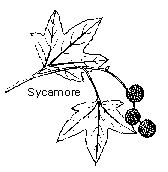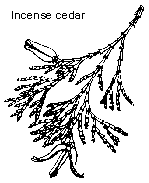 Medford Station 9: Just Plane Sycamore
Medford Station 9: Just Plane Sycamore
THE SYCAMORE (Planatus sp.), sometimes called the American plane tree, is related to the London plane tree, a popular landscape tree all over Europe. Sycamore and maple trees have very similar leaves, but the trees are easily distinguished: the sycamore has smooth, mottled bark and its leaves alternate on the branch; they are not opposite like the maple's. This massive tree can attain a height of 175 feet. Because the wood is difficult to split, it is frequently used in butcher blocks. Sometimes, in plazas and parks, sycamores are pruned down to short main branches with knotty ends that produce many leafy branchlets, providing a dense canopy of shade, a technique called "pollarding."
The incense cedar (Calocedrus decurrens) next to the path is a native evergreen tree with scale-like leaves and small, one-inch cones that look like Donald Duck with his mouth open. It is a drought-resistant tree with durable aromatic wood that is mainly used for pencils and fence posts. Other uses include mothproof chests, Venetian blinds, grape stakes, and shakes. The Shasta Indians built their houses out of split incense cedar.



















